The IRS 1099-MISC form is used to report various types of income received by individuals and businesses that are not classified as wages. This form is typically issued to independent contractors, freelancers, and other non-employees who have earned $600 or more in a tax year from a single payer. It helps the IRS track income that may not be reported on a W-2 form.
Businesses and individuals who pay $600 or more to a non-employee for services rendered must file a 1099-MISC form. This includes payments made to:
-
Independent contractors
-
Freelancers
-
Rent payments
-
Prizes and awards
-
Medical and healthcare payments
It's important to note that there are specific thresholds and exceptions, so reviewing the IRS guidelines is crucial.
The deadline for filing the 1099-MISC form is typically January 31st of the year following the tax year in which the payments were made. This deadline applies whether you are filing electronically or by mail. If the deadline falls on a weekend or holiday, it may be extended to the next business day.
To complete the 1099-MISC form, you will need the following information:
-
The payer's name, address, and taxpayer identification number (TIN).
-
The recipient's name, address, and TIN.
-
The total amount paid to the recipient during the tax year.
-
Any applicable tax withholding amounts.
Ensuring that all information is accurate is essential to avoid potential penalties.
Failing to file a 1099-MISC form can result in penalties. The amount of the penalty depends on how late the form is filed:
-
$50 per form if filed within 30 days of the due date.
-
$100 per form if filed more than 30 days late but by August 1st.
-
$260 per form if filed after August 1st or not filed at all.
In addition to these penalties, failure to provide accurate information can lead to further complications, including audits.
Yes, you can file the 1099-MISC form electronically. The IRS encourages electronic filing, especially for businesses that need to submit multiple forms. You can use the IRS e-file system or third-party software to file electronically. Remember, if you file 250 or more forms, electronic filing is mandatory.
If you receive a 1099-MISC form that contains incorrect information, it is important to address the issue promptly. Contact the issuer of the form to request a corrected version. The issuer should issue a corrected 1099-MISC, which is known as a 1099-MISC-C. Once you receive the corrected form, ensure that you report the accurate information on your tax return.
